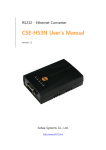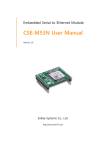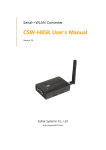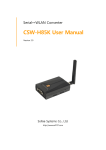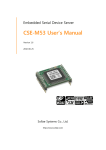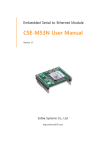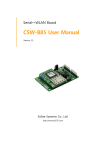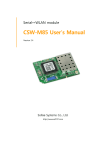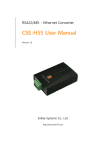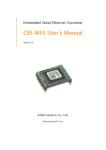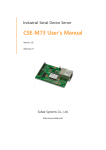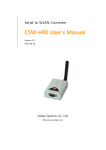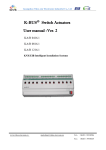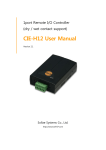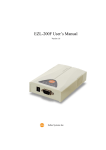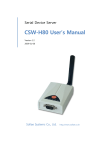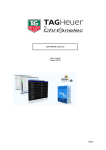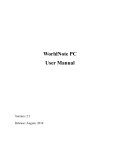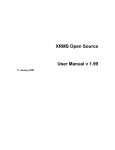Download CSE-H55N User`s Manual
Transcript
RS422/485 - Ethernet Converter CSE-H55N User’s Manual Version 1.2 Sollae Systems Co., Ltd. http://www.ezTCP.com CSE-H55N User’s Manual Ver. 1.2 Contents 1 Overview ..................................................................................................................................- 4 - 1.1 Overview ................................................................................................................................................................ - 4 1.2 Features .................................................................................................................................................................. - 4 1.3 Application Examples ....................................................................................................................................... - 5 1.4 Components ......................................................................................................................................................... - 7 1.5 Specification ......................................................................................................................................................... - 8 - 1.5.1 Hardware ...................................................................................................................................................... - 8 1.5.2 Software ........................................................................................................................................................ - 8 1.6 Interfaces ............................................................................................................................................................... - 9 - 1.6.1 Serial Interface ........................................................................................................................................... - 9 1.6.2 Ethernet Interface .................................................................................................................................. - 11 1.6.3 Power ........................................................................................................................................................... - 12 1.7 System LED ........................................................................................................................................................ - 13 - 1.7.1 Function button ...................................................................................................................................... - 14 2 Installation and Test ............................................................................................................ - 15 - 2.1 Installation .......................................................................................................................................................... - 15 - 2.1.1 Setting Network Aera .......................................................................................................................... - 16 2.2 Simple Test ......................................................................................................................................................... - 18 3 Configuration ....................................................................................................................... - 21 - 3.1 Configuration with ezManager ................................................................................................................. - 21 - 3.1.1 Configuration via LAN ......................................................................................................................... - 21 3.1.2 Configuration via Serial ...................................................................................................................... - 22 3.2 AT command ..................................................................................................................................................... - 23 4 Operation Modes ................................................................................................................ - 24 - 4.1 What is the Operation Mode? .................................................................................................................. - 24 4.2 How to entering each mode ..................................................................................................................... - 24 4.3 Comparison of each mode ......................................................................................................................... - 25 4.4 Normal Mode ................................................................................................................................................... - 25 4.5 Serial Configuration Mode ......................................................................................................................... - 26 4.6 ISP Mode ............................................................................................................................................................ - 26 - 4.6.1 Upgrading Firmware............................................................................................................................. - 26 - -1- http://www.ezTCP.com CSE-H55N User’s Manual Ver. 1.2 4.6.2 Revoking Serurity Options................................................................................................................. - 26 5 Communication Modes ...................................................................................................... - 27 - 5.1 TCP Server .......................................................................................................................................................... - 27 - 5.1.1 Key parameters ....................................................................................................................................... - 27 5.1.2 Examples .................................................................................................................................................... - 28 5.2 TCP Client ........................................................................................................................................................... - 31 - 5.2.1 Key parameters ....................................................................................................................................... - 31 5.2.2 Examples .................................................................................................................................................... - 32 5.3 AT Command .................................................................................................................................................... - 35 - 5.3.1 Key parameters ....................................................................................................................................... - 35 5.3.2 Examples .................................................................................................................................................... - 36 5.4 UDP ....................................................................................................................................................................... - 39 - 5.4.1 Key parameters ....................................................................................................................................... - 39 5.4.2 Examples .................................................................................................................................................... - 40 6 System Management .......................................................................................................... - 42 - 6.1 Upgrading Firmware ...................................................................................................................................... - 42 - 6.1.1 Firmware .................................................................................................................................................... - 42 6.1.2 Processes ................................................................................................................................................... - 42 6.2 Status Monitoring ........................................................................................................................................... - 44 - 6.2.1 Using TELNET .......................................................................................................................................... - 44 6.2.2 Using ezManager ................................................................................................................................... - 46 6.3 Factory Reset ..................................................................................................................................................... - 50 - 6.3.1 Using Factory Reset .............................................................................................................................. - 50 6.3.2 Setting custom default values ......................................................................................................... - 51 7 Security Function ................................................................................................................. - 52 - 7.1 SSL ......................................................................................................................................................................... - 52 7.1.1 What is the SSL(Secure Socekt Layer)? ...................................................................................... - 52 7.1.2 How to set the SSL ................................................................................................................................ - 52 7.1.3 Restriction.................................................................................................................................................. - 53 7.2 Access Restriction (ezTCP Firewall) ......................................................................................................... - 54 - 7.2.1 Setting Password .................................................................................................................................... - 54 8 Additional Functions ........................................................................................................... - 55 - 8.1 Notify IPv4 Change ........................................................................................................................................ - 55 - -2- http://www.ezTCP.com CSE-H55N User’s Manual Ver. 1.2 8.2 Sending MAC Address.................................................................................................................................. - 56 8.3 Serial Port Tab Functions ............................................................................................................................. - 57 - 8.3.1 Disable TCP Transmission Delay - ① ........................................................................................... - 57 8.3.2 Data Frame Interval - ② .................................................................................................................... - 57 8.3.3 Separator - ③.......................................................................................................................................... - 58 8.3.4 TCP Server / Client mode - ④ ........................................................................................................ - 58 9 RS485/RS422 Interface ....................................................................................................... - 59 - 9.1 About RS485/RS422 Network ............................................................................................................... - 59 9.2 Configuring an RS485 Network ............................................................................................................ - 59 9.2.1 Signal Ground .......................................................................................................................................... - 59 9.2.2 Biasing Resistors .................................................................................................................................... - 59 9.2.3 Termination Resistors ........................................................................................................................... - 60 9.3 Configuring an RS422 Network ............................................................................................................ - 60 9.3.1 1:1 Configuration .................................................................................................................................... - 60 9.3.2 1:N Configuration ................................................................................................................................... - 60 9.3.3 Signal Ground, Biasing and Termination Resistors ................................................................. - 61 10 Checklist in Trouble............................................................................................................. - 62 - 10.1 Searching problem with ezManager ...................................................................................................... - 62 10.2 Connection Problem over TCP/IP ............................................................................................................ - 63 10.3 Data Communication Problem over the Serial Port ....................................................................... - 64 11 Technical Support, Warranty, and Precaution ................................................................ - 65 - 11.1 Technical Support ........................................................................................................................................... - 65 11.2 Warranty .............................................................................................................................................................. - 65 - 11.2.1 Refund ......................................................................................................................................................... - 65 11.2.2 Free Repair Services ............................................................................................................................. - 65 11.2.3 Charged Repair Services..................................................................................................................... - 65 11.3 Precaution........................................................................................................................................................... - 66 12 Revision History ................................................................................................................... - 67 - -3- http://www.ezTCP.com CSE-H55N User’s Manual Ver. 1.2 1 Overview 1.1 Overview Almost all communication devices including PC are using serial transmission. In this type, devices send and receive data in the order of each byte. The serial communication is quite simple to implement but has weaknesses like short distance and hard maintenance. CSE-H55N lets the serial devices connect to the Internet. To communicate on the Internet, devices should use TCP/IP protocol, so CSE-H55N processes the converting serial data to TCP/IP. 1.2 Features IPv4 / IPv6 dual stack Stateless / Stateful (DHCPv6) address auto-configuration RS422/RS485 (Terminal Block) Industrial temperature range (-40℃ ~ +85℃) Variety of monitoring status (ezManager, TELNET) Security Protocols SSL3.0/TLS1.0 -4- http://www.ezTCP.com CSE-H55N User’s Manual Ver. 1.2 1.3 Application Examples 1:1 Connection with a PC Figure 1-1 1:1 connection with a PC Applied to LANs Figure 1-2 applied to LANs Applied to the Internet on Cable Networks Figure 1-3 applied to the Internet on cable networks -5- http://www.ezTCP.com CSE-H55N User’s Manual Ver. 1.2 Applied to the Internet with an IP Share Router Figure 1-4 applied to the Internet with an IP share router Applied to a serial tunneling system Figure 1-5 applied to a serial tunneling system Applied to a multi-drop network. Figure 1-6 applied to a multi-drop network -6- http://www.ezTCP.com CSE-H55N User’s Manual Ver. 1.2 1.4 Components CSE-H55N’s Body CD, including utilities and documents (option) DC 5V Adapter (Option) -7- http://www.ezTCP.com CSE-H55N User’s Manual Ver. 1.2 1.5 Specification 1.5.1 Hardware Power Input Voltage DC 5V (±10%) Current 165mA typical Dimension 94mm x 57mm x 24mm Weight About 63g Serial Serial Port RS422 / RS485 (Baud Rate: 1,200bps ~ 230,400bps) 10 Base-T or 100 Base-TX Ethernet Auto-Sensing Network Auto MDI or MDIX cable Auto-Sensing Temperature Storage / Operating Temperature: -40 ~ 85℃ Approval KC, CE RoHS RoHS Compliant Table 1-1 Hardware specification 1.5.2 Software Protocol TCP, UDP, IPv4/IPv6 dual stack, , ICMPv6/TCPv6/UDPv6 ICMP, ARP, DHCP, PPPoE, DNS, DDNS(Dynamic DNS), Telnet, SSL Normal For Normal Data Communication ISP For Upgrading F/W Serial Configuration For Configuration via Serial TCP Server TCP Passive Connection Communicat TCP Client TCP Active Connection ion mode AT Command TCP Passive / Active Connection UDP UDP Operation mode Major Utilities ezManager ezVSP Configuration Utility for MS Windows (Supports Downloading F/W) Serial to TCP/IP Virtual driver for MS Windows Table 1-2 Software specification -8- http://www.ezTCP.com CSE-H55N User’s Manual Ver. 1.2 1.6 Interfaces 1.6.1 Serial Interface CSE-H55N has a serial port for user serial device (1,200bps ~ 230,400bps). This port is interfaced with 6-pins terminal block and the each pin should be fixed by a flat-head screwdriver driver. Figure 1-7 6 pins Terminal block Pin Assignment for RS-422 Number Name Description 1 TX + Transmit Data + 2 TX - Transmit Data - 3 GND Ground 4 RX + Receive Data + 5 RX - Receive Data - 6 GND Ground Level I/O Etc. RS422 OUT Required - - Required RS422 IN Required - - Required Table 1-3 pin assignment of the RS422 Pin Assignment for RS-485 Number Name Description Level 1 TRX + Transmit / Receive Data + 2 TRX - Transmit / Receive Data - 3 GND Ground - - Required 6 GND Ground - - Required RS485 I/O OUT IN Etc. Required Table 1-4 pin assignment of the RS485 We recommend to connect with GND pin according to EIA/TIA-485A aggrement. -9- http://www.ezTCP.com CSE-H55N User’s Manual Ver. 1.2 Serial Port Parameters Parameter Value Number 1 Type RS422 / RS485 Baud rate 300 ~ 230,400 [bps] Parity NONE / EVEN / ODD / MARK / SPACE Data bit 8 Stop bit 1 / 1.5 / 2 Flow control NONE / RTS/CTS Table 1-5 serial port parameters - 10 - http://www.ezTCP.com CSE-H55N User’s Manual Ver. 1.2 1.6.2 Ethernet Interface Since part of CSE-H55N network is composed of Ethernet, UTP cable may be connected. It will automatically sense 10Mbits or 100Mbits Ethernet and connect itself. It also provides auto MDI/MDIX function that can automatically sense 1:1 cable or cross over cable. Figure 1-8 RJ45 the Ethernet interface RJ45 the Ethernet port interface Number Name Direction 1 TX+ Output 2 TX- Output 3 RX+ Input 4 - - 5 - - 6 RX- Input 7 - - 8 - - Table 1-6 RJ45 the Ethernet port interface Status of the system RJ45 LED Color LED status Blinks in every second Yellow Blinks 4 times at once Green Description Obtaining an IP address Without obtaining an IP address under DHCP or PPPoE network On Connecting with TCP On Connecting with Ethernet Off Not connecting with Ethernet. blinks Data is in network Table 1-7 LED status on the RJ45 LED - 11 - http://www.ezTCP.com CSE-H55N User’s Manual Ver. 1.2 1.6.3 Power DC 5V is used for the power. The specifications of the power jack are as the following: Figure 1-9 power jack - 12 - http://www.ezTCP.com CSE-H55N User’s Manual Ver. 1.2 1.7 System LED CSE-H55N has several lamps to show the current system status. Each lamp shows the following status: Mode Common Name Color Status Description PWR Red On Supplying the power LINK Green On Connecting with Ethernet RXD Yellow Blinks Receiving data from the Ethernet TXD Green Blinks Sending data to the Ethernet Blinks in every Normal STS mode ISP mode Serial Configuration mode Obtaining an IP address second Yellow Blinks 4 times Without obtaining an IP address at once under DHCP or PPPoE network On Connecting with TCP Off Entering ISP mode STS Yellow STS Yellow LINK Green Blinks RXD Yellow simultaneously TXD Green Entering Serial Configuration mode Table 1-8 LED status on the top panel Mode Common Name Color Status Description Yellow Blinks Receiving data from the serial port Green Blinks Sending data to the serial port Table 1-9 LED status on the front panel The green LED on the left side of RJ45 connecter is connected to LINK LED and the yellow LED on the right side is connected to STS LED. Figure 1-10 the front side panel - 13 - http://www.ezTCP.com CSE-H55N User’s Manual Ver. 1.2 1.7.1 Function button There is a switch, which is named function switch (or button) located on the side of the product. You can change the operation mode of CSE-H55N to ISP or Serial Configuration mode with this switch. And it is used for factory reset. Figure 1-11 function switch - 14 - http://www.ezTCP.com CSE-H55N User’s Manual Ver. 1.2 2 Installation and Test 2.1 Installation Before testing CSE-H55N, users should connect both serial and Ethernet port to a PC. To connect the RS232 port of your PC and CSE-H55N via serial, you need a RS232 to RS422/RS485 converter. It will be no problem that the Ethernet connection includes network hubs. In case if your PC doesn’t have a RS232 port, use a USB to RS232 cable. Figure 2-1 connection between CSE-H55N and a PC - 15 - http://www.ezTCP.com CSE-H55N User’s Manual Ver. 1.2 2.1.1 Setting Network Area This step is for setting both CSE-H55N and users’ PC to be located the same network. If only they are, the TCP connection between them can be established. Setting of the PC Add or change the IP address of the network adapter on your PC like following. Get into the menu of [Windows Control Panel] >> [Network Connections] >> [Properties of the Network Adapter – with right click of your mouse]. Then, you can show the properties of [Internet Protocol (TCP/IP). In there, press the [Advanced..] button for adding an IP Address like the below figure. Figure 2-2 adding / changing the IP address of users’ PC - 16 - http://www.ezTCP.com CSE-H55N User’s Manual Ver. 1.2 Setting of CSE-H55N CSE-H55N uses ezManager as it’s a configuration program. ezManager is for MS Windows, and this is comfortable to use because it doesn’t need installation. First, search your CSE-H55N via network. All the values of parameters are set the default values in the factory. To apply it to your system, proper values should be set via ezManager. Major parameters’ default values are listed on below table. To implement this simple test, keep these values without any changes. Name Network Option Serial Port (COM1) Default Values Local IP Address 10.1.0.1 Subnet Mask 255.0.0.0 IPv6 Disable TELNET Checked IP Address Search Checked Serial Type RS485 Baud Rate 19,200bps Parity NONE Data Bits 8 Stop Bit 1 Communication mode TCP Server Local Port 1470 Table 2-1 default values of Major parameters Refer to ezManager website for more details. - 17 - http://www.ezTCP.com CSE-H55N User’s Manual Ver. 1.2 2.2 Simple Test If you press the [Simple Test] button, test program will be shown on your screen. Connecting to the CSE-H55N via LAN Figure 2-3 settings for TCP connection ① Select [TCP Client] ② Input correct IP address and port number of CSE-H55N ③ Clink the [Connect] button. (In case of TCP Server, it will be [Listen] button) Opening RS232 Port Figure 2-4 opening COM Port ④ Select COM port where the CSE-H55N is being connected. ⑤ Make sure that all the parameters are the same with CSE-H55N. ⑥ Press the [Open] button - 18 - http://www.ezTCP.com CSE-H55N User’s Manual Ver. 1.2 Confirm the TCP Connection and COM port status Figure 2-5 TCP Connected message ⑦ Check the message if the TCP connection has been established well. Figure 2-6 COM Port open message ⑧ Check the message if the COM port has been opened - 19 - http://www.ezTCP.com CSE-H55N User’s Manual Ver. 1.2 Data transmission test Figure 2-7 successful data transmission ⑨ Click the [Send data] on the LAN side. ⑩ Check the data have been shown from the step ⑨. Figure 2-1 LAN → RS232 ⑪ Press the [Send data] on the RS232 side. ⑫ Check the data from ⑪ has been received. Figure 2-2 RS232 → LAN - 20 - http://www.ezTCP.com CSE-H55N User’s Manual Ver. 1.2 3 Configuration 3.1 Configuration with ezManager Figure 3-1 initial appearance of ezManager 3.1.1 Configuration via LAN Checklists Make sure the connection between your PC and CSE-H55N. If they are the same network, [MAC Address search] button can be used. If they aren’t, only [IP Address search] is allowed to use. Procedures Figure 3-2 procedures for configuration via LAN - 21 - http://www.ezTCP.com CSE-H55N User’s Manual Ver. 1.2 3.1.2 Configuration via Serial Checklists To use serial configuration, COM port of PC should be connected with CSE-H55N. Because CSE-H55N doesn’t have a RS232 port, a RS232 to RS422/485 converter is needed. Of course, CSE-H55N should be in operation as [Serial Configuration Mode]. Procedures Figure 3-3 procedures for configuration via Serial Step 2, Reading Figure 3-4 reading procedure via serial ① Choose the [Serial] tab ② Select the COM port which the CSE-H55N is connected with ③ Open the COM port with the [Open] button ④ Load the setting with [Read] button If you want to know more specific manners of setting, please refer to the document “ezManager Users’ Manual” on the [Download] >> [Technical Document] of our website. - 22 - http://www.ezTCP.com CSE-H55N User’s Manual Ver. 1.2 3.2 AT command In the AT command mode, you can change some parameters through the serial port. Checklists Make sure the connection between your PC and CSE-H55N using RS232 cross cable. To use this, CSE-H55N has to be set to [AT command] mode as its communication mode. This can be configured by ezManager. Figure 3-5 setting the communication mode to the AT command Procedures Figure 3-6 procedures for configuration with AT command Division IP Address related items TCP connection related items Option Available parameters Local IP Address, DHCP, PPPoE, Subnet Mask, Gateway IP Address, DNS IP Address, ··· Local Port, Peer Address (IP Address or Host name), Peer Port, ··· ESC code sending option, timeout, ··· Table 3-1 parameters which are available to change with AT command Including above items, rest of parameters can be set by ezManager - 23 - http://www.ezTCP.com CSE-H55N User’s Manual Ver. 1.2 4 Operation Modes 4.1 What is the Operation Mode? Each of three operation mode of CSE-H55N is defined for specific purpose, and those are followed. Normal mode This mode is for normal data communication and has 4 different connection modes. Configuring parameters is also available in this mode. Serial configuration mode This mode is for configuring environmental parameters through the RS-422 port. ISP mode This mode is for upgrading firmware. In addition, you can set environmental parameters even though the security options like password are activated by entering this mode. 4.2 How to entering each mode Figure 4-1 How to entering each mode ① Push the function button less than 1 second. ② Reset ③ Transfer a firmware by ezManager ④ Push the function button over than 1 second. - 24 - http://www.ezTCP.com CSE-H55N User’s Manual Ver. 1.2 4.3 Comparison of each mode Name Serial port Serial type Normal configured value RS422 / RS485 Serial Configuration 115,200/N/8/1 RS422 ISP - - Table 4-1 comparison of each mode 4.4 Normal Mode In normal mode, there are four connection types to communication with a remote host. TCP Server TCP Client AT Command UDP Modifying Name Protocol Connection software of serial devices TCP Server TCP Client TCP AT Command UDP UDP Serial configuration Topology Passive - Unavailable 1:1 Active - Unavailable 1:1 Either Required Available 1:1 - - Unavailable N:M Table 4-2 comparison of four communication modes TCP is a type of protocol, which has a process of connection. The connection has to be one to one. The part who tries to make the connection is called TCP Client, and the other part is TCP Server. On the other hand, UDP has no connection process. Because of this, each of them can be send and receive data from multiple hosts. - 25 - http://www.ezTCP.com CSE-H55N User’s Manual Ver. 1.2 4.5 Serial Configuration Mode This mode is for setting environmental parameters through the serial port. ezManager has an interface for this mode. Use the [Read] button on the [Serial] tab. 4.6 ISP Mode You can enter this mode by pressing the function button over 1 seconds. There are two special purposes in this mode. 4.6.1 Upgrading Firmware ISP mode is for upgrading firmware which is offered by us. The upgrade is implemented on Ethernet. The details are followed in the “6.1 Upgrading Firmware”. 4.6.2 Revoking Serurity Options CSE-H55N offers restriction methods for security like filtering password or MAC and IP address. In the ISP mode, you can revoke all of these. When you forgot the password, enter the ISP mode to solve the problem. When you change the environment values on the ISP mode, a part of values may randomly change. If you quit the configuration, please check again on the normal mode - 26 - http://www.ezTCP.com CSE-H55N User’s Manual Ver. 1.2 5 Communication Modes 5.1 TCP Server In this mode, CSE-H55N listens to a TCP connection request from remote hosts. Once a host tries connecting to CSE-H55N, it accepts a connection. After the connection is established, CSE-H55N converts the raw data from the serial port to TCP/IP data and sends it to the network and vice versa. 5.1.1 Key parameters Local Port This is a server’s port number which is used in the TCP connection. Event Byte With setting event bytes, you can handle the serial data of the serial buffer before a TCP connection is established. Value 0 Otherwise (512 or under) Description CSE-H55N doesn’t send the data CSE-H55N sends the data right after a connection is established. 512 or under bytes are strongly recommended. Table 5-1 Event Byte Timeout If there is no transmission data for amount of the time the connection would be terminated. Notify IP Change This function is for notifying information about changed IP addresses to a management server. Not only can the TCP/UDP protocol be used, but Dynamic Domain Name Service (DDNS). Access restriction You can block TCP connections from unauthorized hosts by using this option. Both IP and MAC address are available. - 27 - http://www.ezTCP.com CSE-H55N User’s Manual Ver. 1.2 5.1.2 Examples A situation that [Event Byte] is set to 0. Figure 5-1 time chart Points States ~ CSE-H55N is listens to connection requests ① Remote host sends a connection request (SYN) segment ~ Processes of the connection ② The connection is established ~ Data communication is implemented on both side Table 5-2 states of each point Look at the blue arrow. The data “123” from the serial port has been sent before establishing a connection. In this case, the data would not be sent because of the [Event Byte] is set to 0. - 28 - http://www.ezTCP.com CSE-H55N User’s Manual Ver. 1.2 A situation that [Event Byte] is set to 1. Figure 5-2 time chart Points States ~ CSE-H55N listens connection requests ① Remote host sends a connection request (SYN) segment ~ Processes of the connection ② The connection is established ~ Data communication is implemented on both sides Table 5-3 states of each point As you can see, the data “123” has been sent right after establishing a connection because the value of [Event Byte] had been set to 1. - 29 - http://www.ezTCP.com CSE-H55N User’s Manual Ver. 1.2 A situation that [Timeout] is set to 5. Figure 5-3 time chart Points States ~ Data communication on both sides ① The last segment arrives at the CSE-H55N ~ No data communication for 5 seconds ② CSE-H55N send disconnection request (Fin) to a remote host ~ Processes of the disconnection ③ The connection is terminated ~ CSE-H55N listens connection requests Table 5-4 states of each point - 30 - http://www.ezTCP.com CSE-H55N User’s Manual Ver. 1.2 5.2 TCP Client In this mode, CSE-H55N sends request segments to a TCP server with information of [Peer Address] and [Peer Port]. Once a host is listening, the connection will be established. After then, CSE-H55N converts the raw data from the serial port to TCP/IP data and sends them to the network and vice versa. 5.2.1 Key parameters Peer Address This item is an address of TCP server Peer Port [Peer Port] is a port number of TCP server. Event Byte This item can decide the point of time to send the connection request parameter. Value 0 Otherwise (512 or under) Description Right after CSE-H55N boots up right after the bytes set to [Event Byte] have been received from the serial port Setting to less than 512 bytes is strongly recommended. Table 5-5 the operation of Event Byte 1 In addition, you can handle the serial data before a TCP connection is established with this parameter. Value 0 Otherwise (512 or under) Description CSE-H55N does not send the data CSE-H55N sends the data right after a connection is established. Setting to less than 512 bytes is strongly recommended. Table 5-6 the operation of Event Byte 2 Timeout If there is no data transmission for amount of the time the connection would be terminated. TCP Server This check option enables you to get to the TCP Server / Client mode. In this mode, CSE-H55N can be operated as a TCP server or client without changing its settings. - 31 - http://www.ezTCP.com CSE-H55N User’s Manual Ver. 1.2 DNS IP Address [DNS IP Address] needs when you use host name instead of the IP address. 5.2.2 Examples A situation that [Event Byte] is set to 0. Figure 5-4 time chart Points States ~ Power is not supplied yet. ① CSE-H55N sends a connection request segment right after it boots up ~ Processes of TCP connection ② The connection is established. ~ Data communication on both sides Table 5-7 state of each point Look at the blue arrow. The data “123” from the serial port was sent before establishing a connection. In this case, the data would not be sent because of the [Event Byte] is set to 0. - 32 - http://www.ezTCP.com CSE-H55N User’s Manual Ver. 1.2 A situation that [Event Byte] is set to 5. Figure 5-5 time chart Points ~ ① States CSE-H55N receives data from its serial port. CSE-H55N sends a connection request segment right after receiving 5 bytes. ~ Processes of the TCP connection ② The connection is established ~ The data “1234567” is transmitted to the remote host Table 5-8 states of each point As you can see, CSE-H55N has sent a request segment right after the size of the serial data has been 5 bytes. Even though they arrived before the connection, the data “123”, “45” and “67” was transmitted to the remote host because the [Event Byte] is set to 5. - 33 - http://www.ezTCP.com CSE-H55N User’s Manual Ver. 1.2 An activated [TCP Server] option Figure 5-6 time chart for activating [TCP Server] option Points States ~ CSE-H55N is listening to connection requests ① The connection has been established ~ CSE-H55N is on line and processes of the disconnection ② The connection has been terminated ~ Both sides are offline ③ Sends TCP connection request segment Table 5-9 state description The TCP Server / Client mode can be useful option by using [Event Byte] and [Timeout]. Note that only one TCP connection can be established at the same time, so users should consider setting [Timeout] properly. The details are followed in the “TCP Server/Client mode”. - 34 - http://www.ezTCP.com CSE-H55N User’s Manual Ver. 1.2 5.3 AT Command AT command is a mode which users control CSE-H55N with AT command like controlling modem. In this mode, active and passive TCP connections are available. And users are allowed to configure some environmental parameters with extended commands. 5.3.1 Key parameters The configuration should be implemented via the serial port of CSE-H55N Commands Description Examples +PLIP Local IP Address at+plip=10.1.0.1<CR> +PLP Local Port at+plp=1470<CR> +PRIP Peer IP Address at+prip=10.1.0.2<CR> +PRP Peer Port at+prp=1470<CR> +PDC DHCP at+pdc=1 (ON)<CR> +PPE PPPoE at+ppe=1 (ON)<CR> +PTO Timeout at+pto=10<CR> +PWP Store setting at+pwp<CR> Table 5-10 some of extended commands for configuration Related items with IP Address and Local Port Local port can be set as well as IP address related parameters like IP Address, Subnet Mask and Gateway IP Address. Peer Address / Peer Port IP address and local port of a remote host are can be set. Type of assigning IP address: Manual, DHCP, PPPoE Not only manual setting, also automatic assigning protocol (DHCP, PPPoE) are available. Others Some of options including [Timeout] can be configured in this mode. - 35 - http://www.ezTCP.com CSE-H55N User’s Manual Ver. 1.2 5.3.2 Examples TCP Server – setting parameters and passive connection Figure 5-7 time chart Points States ~ configuring parameters with AT commands ① ATA command has arrived. ~ CSE-H55N listens to TCP connection requests. ② A remote host sends SYN segment to CSE-H55N ~ Processes of TCP connection ③ TCP connection is established ~ CSE-H55N sends “CONNECT” message to the serial port Table 5-11 state of each other The details are followed in the “At Command(ATC) Mode”. - 36 - http://www.ezTCP.com CSE-H55N User’s Manual Ver. 1.2 TCP Client – setting parameters and active connection Figure 5-8 time chart Points ~ ① States configuring parameters with AT commands CSE-H55N sends a TCP connection request with the ATD command ~ Processes of TCP connection ② TCP connection is established ~ CSE-H55N sends “CONNECT” message to the serial port Table 5-12 state of each other - 37 - http://www.ezTCP.com CSE-H55N User’s Manual Ver. 1.2 Termination of online status – entering the AT command mode Figure 5-9 time chart Points ~ ① States TCP connection is on-line. The mode is changed to “command mode” after receiving “+++”. ~ command mode (TCP connection is off-line) ② CSE-H55N sends FIN segment right after the “ATH” arrives. ~ Processes of TCP disconnection ③ TCP connection is terminated ~ CSE-H55N sends “NO CARRIER” with disconnection Table 5-13 states of each other CSE-H55N changes the mode to AT command, when receiving “+++”. In this state, the communication with remote host is unavailable because CSE-H55N processes only AT commands. Whenever you want to go back to on-line state, just give “ATO” command. For more information about this, please refer to the “ATC mode” on the [Download] >> [Technical Document] menu of our web site. - 38 - http://www.ezTCP.com CSE-H55N User’s Manual Ver. 1.2 5.4 UDP UDP has no connection processes. In this mode, data is sent in block units. Therefore, data that comes through CSE-H55N’s serial port is collected in block units to send it elsewhere. 5.4.1 Key parameters Event Size [Event Byte] is to set the time to gather data in one block. Its unit is byte. If the data in configured size of the [Event Byte] comes into the serial port, CSE-H55N will send them as one block to the network. The maximum value could be 1460 bytes. Data Frame [Data Frame] means the time for gathering data to make one block. Its unit is 10ms. If there is no data from the serial devices during the [Data Frame] time, CSE-H55N sends and receives data in the buffer as one block to the network. Once one of the parameters is sufficient, the block size is decided as the condition. Dynamic update of Peer host If you set the value of [Peer Address] and [Peer Port] to 0, [dynamic update of peer host] function is activated. By using this function, CSE-H55N can communicate to multiple hosts without additional setting. - 39 - http://www.ezTCP.com CSE-H55N User’s Manual Ver. 1.2 5.4.2 Examples Block Size: 5 bytes / Data Frame: 1s (100 by 10ms) Figure 5-10 time chart Points ~ ① States CSE-H55N receives data from the serial port CSE-H55N sends 5 bytes as one block based on the [Event byte]. ~ Serial device sends data “678”. ② The data “678” arrives. ~ ③ ~ CSE-H55N sends data from the remote host to the serial device 1 second CSE-H55N sends data “678” as one block based on the [Data frame]. Table 5-14 state of each point - 40 - http://www.ezTCP.com CSE-H55N User’s Manual Ver. 1.2 Dynamic Update of Peer host This is a function that CSE-H55N automatically sets its peer host with information of the last packet received from network. The source address of the packet is set to the peer host. Parameters Values Peer Address 0 (None) Peer Port 0 Table 5-15 setting for [dynamic update of peer host] function Figure 5-11 time chart Points States ~ Sending any UDP data to the network is impossible. ① UDP data arrives from Remote Host 2. ~ Send UDP data to Remote Host 2. ② UDP data arrives from Remote Host 1. ~ Send UDP data to Remote Host 1. ③ UDP data arrives from Remote Host 2. ~ Send UDP data to Remote Host 2. Table 5-16 state description The data “ABC”, “DE”, “FGH” are from the serial port of CSE-H55N in the Figure 5-11. - 41 - http://www.ezTCP.com CSE-H55N User’s Manual Ver. 1.2 6 System Management 6.1 Upgrading Firmware 6.1.1 Firmware Firmware is a type of software for operation of CSE-H55N. If there are needs for adding function or fixing bugs, the firmware is modified and released. We recommend that users keep use the latest released firmware. 6.1.2 Processes Downloading the latest released firmware Download the newest firmware file. We update our homepage when a new firmware is released. You can find it on our website. Entering ISP mode Enter ISP mode to download firmware file to CSE-H55N. Run a TFTP client and ready to send the F/W file Run a TFTP client program. ezManager is equipped the client program. Click the [Change F/W / HTML] button. Figure 6-1 running TFTP client ① Check the [Advanced Menu] check box ② Click the [Change F/W / HTML] button to run TFTP client ③ Select the [Change Firmware] radio button ④ Input the IP address of CSE-H55N to the [Local IP Address] text box ⑤ Press the [Open Firmware / HTML] button and choose the firmware file - 42 - http://www.ezTCP.com CSE-H55N User’s Manual Ver. 1.2 Checking firmware file and Sending Figure 6-2 sending firmware file ① Check if the name and path of the firmware file are correct ② Click the [Send] button ③ Confirm the completed message - 43 - http://www.ezTCP.com CSE-H55N User’s Manual Ver. 1.2 6.2 Status Monitoring 6.2.1 Using TELNET Once the [TELNET] option is activated, users can remotely log in to CSE-H55N. If a password is set, users should input the password. After then, messages from CSE-H55N appear like the below figure. Figure 6-3 log in to CSE-H55N on TELNET Followed commands let users check each state. Command st sc Option Description Usage net IPv4 Network Status lsh>st net net6 IPv6 Network Status lsh>st net6 sio Serial Port Status lsh>st sio uptime System Uptime lsh>st uptime [op1][op2] Session Control lsh>sc com1 close Table 6-1 Commands for checking states st net “st net” command displays present IPv4 network states of all sessions. Figure 6-4 “st net command” - 44 - http://www.ezTCP.com CSE-H55N User’s Manual Ver. 1.2 st net6 “st net6” command displays present IPv6 network states of all sessions. Figure 6-5 “st net6 command” st sio “st sio” command displays the number of bytes for the serial port. Figure 6-6 “st sio” command st uptime “st uptime” command shows amount of time since CSE-H55N boots up. Figure 6-7 “st uptime” command sc “sc” command is used when users close a session. [op1] means the name of session, and [op2] should be “close”. Figure 6-8 “sc” command In case of the “sc” command you should use only small letters. - 45 - http://www.ezTCP.com CSE-H55N User’s Manual Ver. 1.2 6.2.2 Using ezManager Status of CSE-H55N can be monitored by [Status] button on ezManager. By using the [Refresh Every 1 Second] option in the status window, the status is automatically updated in every second Figure 6-5 status window of ezManager FIRMWARE VERSION The name of model name and the version of firmware are displayed here. SYSTEM UPTIME Amount of time is displayed since CSE-H55N boots up. IP4 NETWORK INFORMATION All information about related items with IPv4 Address is shown here. It works even if the IP address is assigned from DHCP or PPPoE. - 46 - http://www.ezTCP.com CSE-H55N User’s Manual Ver. 1.2 IP6 NETWORK INFORMATION All information about related items with IPv6 Address is shown here. It works even if the IP address is assigned from DHCP or PPPoE. TCP STATE TCP status of each port is shown this section. Message Description LISTEN listening TCP connection CLOSE TCP connection is closed SYN_SENT ESTABLISHED N/A Send “SYN” segment to make TCP connection When TCP connection is established In UDP mode Table 6-2 TCP STATE SERIAL STATUS Amount of data in every buffer is displayed. The unit is byte. Buffer Description sio_rx The number of data which is received from the COM port net_tx The number of data which is sent to the remote host net_rx The number of data which is received from the remote host sio_tx The number of data which is sent to the COM port Table 6-3 SERIAL STATUS - 47 - http://www.ezTCP.com CSE-H55N User’s Manual Ver. 1.2 ARP/ND CACHE TABLE This part shows ARP table on CSE-H55N. When TCP connection is established or UDP data communication is performed, the information of IP and MAC address is automatically stored in the ARP table. This information is held for 1 minute. When 50 seconds is passed, CSE-H55N starts broadcasting the ARP packet again. If there is no response until the time is 0, the information is removed. If there is response, the time is updated 60 seconds again. In IPv6 case, it shows ND cache list. User can check by the ND cache messages. The messages are as follows. Status Description This means the device is standing by after it sends the INCOMPLETE request message, Neighbor Solicitation, to MAC and link local address of an opponent in the initial communication. This means the device has information about the opponent REACHABLE after it sends Neighbor Solicitation, and receives Neighbor Advertisement. STALE The device will change into STALE state after some time later reaching REACHABLE. The device will change into DELAY state if there is no DELAY response to Neighbor Solicitation. In this case, CSE-H53N will not be able to communicate with the device. CSE-H53N will resend the request message to the device in PROBE DELAY state. CSE-H53N will keep sending Neighbor Solicitation until it replies. TCP/IP Connection In this section, the same information with TCP STATE is displayed with IP address and port number. A difference is that users can terminate TCP connection. When right click on a session, a small pop-up window is created. Password This text box is activated when CSE-H55N has a password. If users want to close TCP connection with right click of mouse on the session, this password has to be correctly filled. Refresh Every 1 Second. If this option is checked, ezManager send query in every second. - 48 - http://www.ezTCP.com CSE-H55N User’s Manual Ver. 1.2 IP address Conflict Detection By clicking this button, you can find devices which have the same IP address to yours on the network. Figure 6-10 Without IP address conflict detection Figure 6-11 IP address conflict detection - 49 - http://www.ezTCP.com CSE-H55N User’s Manual Ver. 1.2 6.3 Factory Reset It is a function physically initializes all the setting. You can save a setting to user-defined ENV region and use it as default values by the factory reset. However, if you do not use the region, Factory Reset uses a factory default by manufacturer as its default values. 6.3.1 Using Factory Reset ① Push the function button low 1 second ② Push the function button over 10 seconds LED status is as follow pictures. STS ON LINK ON RXD ON TXD, RXD, LINK, STS, PWR are ON ③ TXD, RXD, LINK, STS are blinks - 50 - http://www.ezTCP.com CSE-H55N User’s Manual Ver. 1.2 6.3.2 Setting custom default values ① Change the mode to Serial Configuration ② Save custom default values by ezManager or serial configuration commands ③ Input the command below b <SPACE> 3c5a <CR> ④ After step ③, current values in the SRAM is saved in user-defined ENV region and the values will be always used for Factory Reset. - 51 - http://www.ezTCP.com CSE-H55N User’s Manual Ver. 1.2 7 Security Function 7.1 SSL 7.1.1 What is the SSL(Secure Socekt Layer)? SSL is cryptographic protocol that provides secure communication on the Internet. The SSL works over TCP. 7.1.2 How to set the SSL To works for SSL, you have to set the SSL-related parameters as the following steps. Set the [SSL] check box in the ezManager. ① Check the [SSL] of the [Option] tab of the ezManager. Figure 7-1 Setting of Option ② After check the [Advanced Menu] of the ezManager , Click the [Certificate]. Figure 7-2 Create the certification ③ Choice the [Write self signed certificate] Figure 7-3 Create the RSA Key - 52 - http://www.ezTCP.com CSE-H55N User’s Manual Ver. 1.2 ④ Input the key length and information in [Self signed certificate] Figure 7-4 Input the information ⑤ Check a success message. Figure 7-5 Check of success message 7.1.3 Restriction If user set the SSL with the CSE-H53N, the other device have to set the SSL. Maximum baud rate of serial port is the 115,200bps. Cannot use SSL feature in IPv6. Cannot use [Disable TCP Transmission Delay] at the same time - 53 - http://www.ezTCP.com CSE-H55N User’s Manual Ver. 1.2 7.2 Access Restriction (ezTCP Firewall) On the [Option] tab of ezManager, you can set access restriction function with MAC and IP address. Allowed MAC Address If this option has a valid value, the device which has the MAC address is only permitted to access. Allowed IP Address This is for qualifying hosts with IP address or range of IP addresses. The range is defined by multiplying [IP address] and [Network Mask] in bit unit. Examples for IPv4 IP Address Network Mask Allowed IP Address Range 10.1.0.1 255.0.0.0 10.1.0.1 ∼ 10.255.255.254 10.1.0.1 255.255.255.0 10.1.0.1 ∼ 10.1.0.254 192.168.1.4 255.255.255.255 192.168.1.4 Table 7-1 examples of defining allowed IPv4 range Apply to ezManager [Apply to ezManager] is for applying above two restrictions to ezManager functions like [Search], [Read], [Write] and etc. Examples for IPv6 IPv6 Address Prefix Allowed IP Address Range 2001:DB8::100 64 2001:DB8::1 ~ 2001:DB8::FFFF 2001:DB8::100 128 2001:DB8::100 Table 7-2 examples of defining allowed IPv6 range 7.2.1 Setting Password A password can be used for protecting CSE-H55N from TELNET login or changing environmental parameters by hosts which are not qualified. The maximum length is 8 bytes of Alphabet or number. When you want to revoke all of these restrictions, operate CSE-H55N as ISP mode. In the mode, all restrictions are removable and communication with ezManager is revoked. - 54 - http://www.ezTCP.com CSE-H55N User’s Manual Ver. 1.2 8 Additional Functions 8.1 Notify IPv4 Change CSE-H55N can be TCP server even though it assigned IP address automatically. Using [Notify IP Change] function, CSE-H55N sends its IP address with the host name to the designed server. There are 3 types- DDNS, TCP and UDP- for this service. Dynamic Domain Name Service (DDNS) CSE-H55N supports DDNS service offered by DynDNS. Therefore, you have to make an account and create host names on the website of DynDNS before you use. All about service usage of an account could be changed according to the policy of DynDNS. DynDNS website: http://dyn.com/dns/ Figure 8-1 setting DDNS ① Select the [DDNS(dyndns.org)] ② 40,320 is a fixed value ③ Input the ID of DDNS account ④ Input the password of the account ⑤ Input a host name which you create on your account TCP/UDP In case you have an own server and want to manage the information about changed IP addresses, you allowed used TCP/UDP for using this option. The [Data Type] can be ASCII or hexadecimal, and the [Interval] is available on configuration. Refer to IP Change Notification for more details. - 55 - http://www.ezTCP.com CSE-H55N User’s Manual Ver. 1.2 8.2 Sending MAC Address [Sending MAC Address] is a function that CSE-H55N sends its MAC address to the remote host right after the connection is established. By using this function, a server can identify multiple devices with the information. Figure 8-2 setting of Sending MAC Address function ① Move to the [Option] tab. ② Check the [Send MAC Address] option. You can use [Send MAC Address] and [SSL] at the same time. Refer to Sending MAC Address Function for more details. - 56 - http://www.ezTCP.com CSE-H55N User’s Manual Ver. 1.2 8.3 Serial Port Tab Functions Figure 8-3 setting of TELNET COM Port Control option 8.3.1 Disable TCP Transmission Delay - ① If you use this option, CSE-H55N sends the data from the serial port to LAN as quickly as possible. 8.3.2 Data Frame Interval - ② Before sending data from the serial port to LAN, CSW-H55N gathers data in the buffer. If there is no data during the time configured in the [Data Frame Interval], it will send data to the network. In case the value is set to 0, data will be sent immediately. The unit is 10ms and this is operated more accurately by checking [Disable TCP Transmission Delay] option. - 57 - http://www.ezTCP.com CSE-H55N User’s Manual Ver. 1.2 8.3.3 Separator - ③ Using this function, you can control the length of network packets by specific characters. separator options Length select the length between 0 ~ 4 bytes Transmit Separators without additional bytes Operation Transmit Separators + 1 byte Transmit Separators + 2 bytes Table 8-1 separator 8.3.4 TCP Server / Client mode - ④ This mode is available on TCP client mode only. In this mode, you do not need to change the mode for switching active or passive TCP connection. Note that the [Event Byte] option should be set to more than 1. Refer to TCP Server / Client mode for more details. - 58 - http://www.ezTCP.com CSE-H55N User’s Manual Ver. 1.2 9 RS485/RS422 Interface 9.1 About RS485/RS422 Network The RS485 and the RS422 are the standards which communicate by differential voltage. These transmission distances are much longer comparing to the RS232. The RS485 is multidriver/multi-receiver system but the RS422 is a single-driver/multi-receiver system. 9.2 Configuring an RS485 Network The following is a general RS485 diagram. GND TR1 BR2 RXRX+ GND GND TRX- TRX- TRX+ TRX+ CSE-H55N USER DEVICE BR1 GND 5V TRXTRX+ USER DEVICE TR2 GND TRXTRX+ USER DEVICE Figure 9-1 General RS485 Network 9.2.1 Signal Ground Even though the RS485 is known as a “two-wire” configuration, an additional ground connection should be implemented. If a signal ground is not used, there might be potential differences between nodes. And it could be electrical noise or damages the transceivers. 9.2.2 Biasing Resistors Two biasing resistors (a pull-up resistor and a pull-down resistor) should be in the RS485 - 59 - http://www.ezTCP.com CSE-H55N User’s Manual Ver. 1.2 network to make differential voltage within the standard. (BR1 and BR2 are biasing resistors in the above picture) In normal case, RS485 line drivers don’t require any biasing resistors, but it makes some problems in some cases. Generally 680 ohm resistors are used for the biasing resistors. If the biasing resistor is higher, power consumption is lower but delay is longer. And if the biasing resistor is lower, delay might is shorter but power consumption will be higher. 9.2.3 Termination Resistors There should be two termination resistors in the ends of transmission line to prevent reflection waves when the cable is long or communication speed is fast. (TR1 and TR2 are termination resistors in the above picture.) The resistors’ resistance should be same to cable’s characteristic impedance. Normal cable’s characteristic impedance is 100 ohm or 120 ohm. 9.3 Configuring an RS422 Network 9.3.1 1:1 Configuration The following is 1:1 configuration of RS422. TR1 5V TR2 BR1 GND BR2 RX- TX- RX+ TX+ GND GND TRX- RX- TRX+ RX+ CSE-H55N USER DEVICE Figure 9-2 RS422 1:1 Configuration 9.3.2 1:N Configuration The following is 1:N configuration of RS422. When the CSE-H55N operates as RS422 mode, it can’t be a slave because its driver is driving always. - 60 - http://www.ezTCP.com CSE-H55N User’s Manual Ver. 1.2 TR1 5V BR1 GND BR2 RX- TX- RX+ TX+ GND GND TRX- RX- TRX+ RX+ CSE-H55N USER DEVICE TXTX+ GND RXRX+ USER DEVICE TR2 TXTX+ GND RXRX+ USER DEVICE Figure 9-3 RS422 1:N Configuration 9.3.3 Signal Ground, Biasing and Termination Resistors Like RS485, the RS422 requires signal ground connections, biasing resistors and termination resistors. Please refer to the RS485 section for more information. - 61 - http://www.ezTCP.com CSE-H55N User’s Manual Ver. 1.2 10 Checklist in Trouble When users are in trouble with CSE-H55N, make sure all the followed steps first. 10.1Searching problem with ezManager Confirming types of configuration utility CSE-H55N can be configured by ezManager. Stopping Firewall operation Firewalls of personal computer or network block broadcast packets. Stop all the firewalls before searching CSE-H55N Most of vaccine programs have firewall functions so it can cause some trouble to search CSE-H55N. Stop these programs before the searching. Stable supply of the power Check if the power is supplied continually. If the power is constantly supplied, the PWR (Red) LED on the CSE-H55N’s body will be turned ON. Connection with the network Make sure that the network connection is fine including Ethernet cable. In this step, we recommend that users connect CSE-H55N with PC directly or in the same network hub. Checking options of restriction In case that restriction of access is activated, the communication with ezManager can be impossible. When users are in this situation, make CSE-H55N operate in ISP mode. - 62 - http://www.ezTCP.com CSE-H55N User’s Manual Ver. 1.2 10.2Connection Problem over TCP/IP Checking parameters related with TCP/IP When CSE-H55N has a private network IP address, personal computer’s IP address has to be the same sub network. Check if the IP address and local port number are correct. In case of a fixed IP address, the subnet mask, gateway IP address and DNS IP address should be configured. TCP Server side TCP Client side Local IP Address, Local Port, Subnet Mask, Local IP Address, Peer Address, Peer Port, Subnet Gateway IP Address, DNS IP Address, DDNS Mask, Gateway IP Address, DNS IP Address, Table 10-1 major parameters related with TCP/IP PING Test Confirm the connection over the network by PING test. If the CSE-H55N doesn’t send any reply from the request, check the network environment. Firewall In case the networks which need strong security, the access may be denied by their firewall. Under this circumstance, users should ask the person in charge of their network to release ports which will be used. (Ex: TCP 1470, UDP 50005) Operation Mode TCP connection is not possible when CSE-H55N is operating in the ISP or Serial Configuration mode. Communication Mode To make TCP connection, both a server and client should exist. If there are only servers or clients, TCP connection can’t be established. ezTCP Firewall When users set the ezTCP firewall with MAC and IP address, any hosts can’t be reachable to it except for the hosts which have the allowed MAC and IP address. Inactivate the option or check the setting is correct. Checking the TCP status TCP is a protocol connected one to one without multiple connection function. Because of this, if a device is on TCP connection, other requests are denied. If users are in this situation, check the network status by connecting on TELNET or using ezManager. - 63 - http://www.ezTCP.com CSE-H55N User’s Manual Ver. 1.2 10.3Data Communication Problem over the Serial Port Connection of Pins Check if the connection of each pin is right. Using cables, users choose the right type of cable which is suitable for the device. Each pin should be connected with the same polarity like the below figures. Figure 10-1 RS485 connection Figure 10-2 RS422 connection Setting parameters Check if all the serial port parameters like Baud Rate, Data bit, Stop bit and Parity are properly set. Contact us if you have any questions about above steps or our products. - 64 - http://www.ezTCP.com CSE-H55N User’s Manual Ver. 1.2 11 Technical Support, Warranty, and Precaution 11.1 Technical Support If you have any question regarding operation of the product, visit Customer Support FAQ corner and the message board on Sollae Systems’ web site or send us an email at the following address: E-mail: [email protected] Website Address for Customer Support: http://www.ezTCP.com/en/support/ 11.2 Warranty 11.2.1 Refund Upon the customer’s request to refund the product within two weeks after purchase, Sollae Systems will refund the product. 11.2.2 Free Repair Services For product failures occurring within two years after purchase, Sollae Systems provides free repair services or exchange the product. However, if the product failure is due to user’s fault, repair service fees will be charged or the product will be replaced at user ’s expense. 11.2.3 Charged Repair Services For product failures occurring after the warranty period (two years) or resulting from user’s fault, repair service fees will be charged and the product will be replaced at user ’s expense. - 65 - http://www.ezTCP.com CSE-H55N User’s Manual Ver. 1.2 11.3 Precaution Sollae Systems is not responsible for product failures occurring due to user ’s alternation of the product. Specifications of the product are subject to change without prior notice for performance improvement. Sollae Systems does not guarantee successful operation of the product if the product was used under conditions deviating from the product specifications. Reverse engineering of firmware and applications provided by Sollae Systems is prohibited. Use of firmware and applications provided by Sollae Systems for purposes other than those for which they were designed is prohibited. Do not use the product in an extremely cold or hot place or in a place where vibration is severe. Do not use the product in an environment in which humidity is high or a lot of oil exists. Do not use the product where there is caustic or combustible gas. Sollae Systems does not guarantee normal operation of the product under the conditions a lot of noise exists. Do not use the product for a purpose that requires exceptional quality and reliability relating to user’s injuries or accidents – aerospace, aviation, health care, nuclear power, transportation, and safety purposes. Sollae Systems is not responsible for any accident or damage occurring while using the product. - 66 - http://www.ezTCP.com CSE-H55N User’s Manual Ver. 1.2 12 Revision History Date Version Comments Author 2012.11.16 1.0 ○ First version has been released. Lisa Shin 2012.12.13 1.1 ○ Change the capture files Lisa Shin 2013.01.11 1.2 ○ Add descriptions of 422/485 Interface Lisa Shin ○ Add caution of saving on the ISP mode - 67 - http://www.ezTCP.com




































































